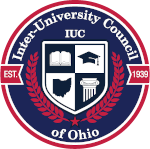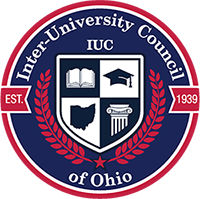 The Inter-University Council of Ohio (IUC) was established in 1939 as a voluntary educational association of Ohio’s public universities. Today the association represents Ohio’s 14 public universities. Together, these institutions offer a broad range of associate, baccalaureate, graduate, and professional programs. The association’s purpose is to facilitate the development of common interest and concern of its members and to assist in sustaining and improving the quality of public higher education. IUC also engages in public relations, research and government liaison work on behalf of its members.
The Inter-University Council of Ohio (IUC) was established in 1939 as a voluntary educational association of Ohio’s public universities. Today the association represents Ohio’s 14 public universities. Together, these institutions offer a broad range of associate, baccalaureate, graduate, and professional programs. The association’s purpose is to facilitate the development of common interest and concern of its members and to assist in sustaining and improving the quality of public higher education. IUC also engages in public relations, research and government liaison work on behalf of its members.
The major goal of the IUC is to sustain a consortium that: establishes a comfortable forum that fosters idea exploration and problem solving; facilitates relationship building and trust among and between presidents and senior campus officers; enables members to achieve together–through collaboration and cooperation–what institutions cannot likely achieve alone.
Greg Crawford, President of Miami University, serves as the current IUC chair beginning September 13, 2022. For an early history of the IUC , please read on.
- Before IUC was formed, university presidents met in Neil House to hash over the budget request from higher education; then one president forwarded this collective request to the governor / state finance director.
- 1938: the presidents of the 5 public institutions in existence at that time – BGSU, Kent, OU, Miami, OSU – formed a mutual protective association on behalf of all five universities.
- 1939: the IUC formally came into being, in large measure to protect the long-term interests of all against the potential of an over-earnest Governor Davey from advancing the interests of the state university located in his home community of Kent. (inaugurated in 1935)
- The five founding campuses initially focused on three areas of commitment:
- To recognize the exclusive mission of Ohio State to award the doctor’s degree in graduate study.
- To present to the administration and legislature an agreed-upon position of operating and capital needs of all five institutions and to defend these in concert.
- To cooperate in all legislation and other public interests concerning the state universities.
- 1948: Wilberforce University, as a state-aided institution, became an IUC member. In 1951, Central State College was created as a separate full-fledged institution split off from and replacing Wilberforce at IUC. (As other state universities were created, they were invited to join IUC.)
- The president and a member of the board of trustees served as representatives for the member institutions. The chief fiscal officers from each institution often were invited to attend as resources to Council members and contributed to the discussions. The chair of the Council was held for a one-year term by a president (who had been president for at least two years) in alphabetical order of the institutions.
- Council convened around the budget process and cycle. Members would discuss their respective needs and the prospects for increasing the appropriations over current levels. Once agreement was reached on a total appropriation amount to request, the chair was delegated authority to begin negotiations with the Governor’s office on behalf of all institutions.
- These negotiations were conducted with the State Director of Finance. Typically, the chair of IUC would insist that the state universities needed an increased appropriation and the state budget director would counter that state revenues were limited and that an increase would be difficult to obtain.
- Once the appropriation for higher education was set, the Council members met to decide how the appropriations would be distributed among the campuses. Generally, the distribution corresponded to enrollments, with Ohio State receiving something more because of its doctoral work and medical school, and Central State receiving more than its proportion because of its small size.
- 1939 – 1963: the administration accepted IUC’s recommendation for the distribution of higher education’s total appropriation among members. Governors and legislatures seem to have readily accepted IUC’s proposed distribution to avoid bitter political battles that would have ensued if they had instead decided on the entitlement or needs of each state university individually.
- Tuition increases were becoming a political issue in Ohio by the early 1960s. Policy makers were criticizing campuses for squeezing all they could out of taxpayers and students. The presidents generally responded that if the state would increase appropriations properly, then the universities would not have to be constantly increasing tuition.
- 1959 – 1964: Interim Commission on Education Beyond High School, created by Gov DiSalle and General Assembly to (among other tasks) recommend who should take the leadership in developing plans to meet Ohio’s future higher education needs.
- 1961: the administration drafted a bill to establish IUC as a legally authorized agency to advise the Governor and the General Assembly on governmental matters affecting higher education, especially appropriations. The bill was presented to the IUC for its consideration and endorsement.
- All but one campus argued that such a law would make IUC an instrumentality of state government rather than an agency of the universities themselves. The Council voted not to endorse the legislation, with the president and trustee of Miami University dissenting.
- 1962: James Rhodes elected Governor. 1963: the General Assembly created the Ohio Board of Regents as the state’s higher education planning and coordinating board.
- Rhodes’ goal to bring a campus within 30 miles of every Ohio student. Quote: “I called the university presidents together and told them we wanted more college branches. Young people want education. These young people need a good job to become wage earners. We want them to have a job in one hand and a diploma in the other.”


 The Inter-University Council of Ohio (IUC) was established in 1939 as a voluntary educational association of Ohio’s public universities. Today the association represents Ohio’s 14 public universities. Together, these institutions offer a broad range of associate, baccalaureate, graduate, and professional programs. The association’s purpose is to facilitate the development of common interest and concern of its members and to assist in sustaining and improving the quality of public higher education. IUC also engages in public relations, research and government liaison work on behalf of its members.
The Inter-University Council of Ohio (IUC) was established in 1939 as a voluntary educational association of Ohio’s public universities. Today the association represents Ohio’s 14 public universities. Together, these institutions offer a broad range of associate, baccalaureate, graduate, and professional programs. The association’s purpose is to facilitate the development of common interest and concern of its members and to assist in sustaining and improving the quality of public higher education. IUC also engages in public relations, research and government liaison work on behalf of its members.